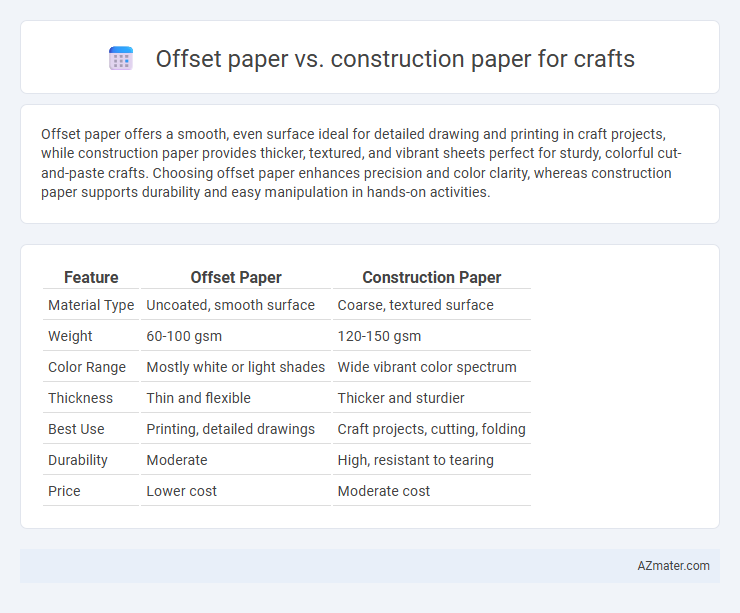Offset paper offers a smooth, even surface ideal for detailed drawing and printing in craft projects, while construction paper provides thicker, textured, and vibrant sheets perfect for sturdy, colorful cut-and-paste crafts. Choosing offset paper enhances precision and color clarity, whereas construction paper supports durability and easy manipulation in hands-on activities.
Table of Comparison
| Feature | Offset Paper | Construction Paper |
|---|---|---|
| Material Type | Uncoated, smooth surface | Coarse, textured surface |
| Weight | 60-100 gsm | 120-150 gsm |
| Color Range | Mostly white or light shades | Wide vibrant color spectrum |
| Thickness | Thin and flexible | Thicker and sturdier |
| Best Use | Printing, detailed drawings | Craft projects, cutting, folding |
| Durability | Moderate | High, resistant to tearing |
| Price | Lower cost | Moderate cost |
Introduction: Understanding Offset Paper and Construction Paper
Offset paper features a smooth finish and high opacity, making it ideal for detailed printing and precision in craft projects requiring sharp lines. Construction paper has a rough texture and vibrant colors, suited for hands-on crafting, layering, and cutting activities due to its thicker and more fibrous composition. Understanding the distinct qualities, thickness, and surface texture of offset and construction paper helps determine the best choice for specific artistic and craft applications.
Key Differences Between Offset Paper and Construction Paper
Offset paper features a smooth, high-quality surface ideal for detailed printing and professional crafts, while construction paper is coarser and thicker, designed for durability and vibrant color projects. Offset paper typically has excellent brightness and opacity, making it suitable for precise artwork and fine ink work, whereas construction paper offers a textured finish that is more resistant to tearing during hands-on crafting. The difference in fiber composition and coating results in offset paper being favored for print media, with construction paper preferred for school projects and bulk craft applications.
Texture and Finish: What Sets Them Apart
Offset paper features a smooth, matte finish with a fine texture ideal for detailed drawing and precise printing, offering a clean and polished appearance. Construction paper, on the other hand, boasts a rougher, fibrous texture with a matte, slightly coarse finish, providing a tactile feel that enhances hands-on craft projects. The distinct surface qualities of offset paper make it suitable for professional-grade art, while construction paper's texture supports versatility and ease of cutting, folding, and layering in creative crafts.
Color Variety and Availability
Offset paper offers a wide range of vibrant colors with consistent hues, making it ideal for detailed craft projects requiring precise color matching. Construction paper provides a broader spectrum of bold, primary colors that are easily accessible and widely available in most craft stores. Availability of construction paper is typically higher due to its lower cost and common use in schools and casual crafts.
Thickness and Durability Comparison
Offset paper typically ranges from 60 to 120 gsm, offering a smooth texture that is thinner and less rigid compared to construction paper, which usually measures between 150 to 300 gsm. Construction paper boasts higher thickness and enhanced durability, making it more resistant to tearing and suitable for heavier craft projects. The denser fiber composition of construction paper ensures better structural integrity, whereas offset paper is ideal for detailed, lightweight applications due to its finer surface.
Suitability for Different Craft Projects
Offset paper offers a smooth surface ideal for detailed drawing, printing, and precision crafts requiring clean lines and vibrant colors. Construction paper, with its coarse texture and sturdy weight, is better suited for children's crafts, collages, and projects involving cutting and layering. Each paper type enhances different craft techniques, making offset paper perfect for fine art applications and construction paper preferable for tactile, hands-on activities.
Printing and Drawing Capabilities
Offset paper offers a smooth, uncoated surface ideal for high-quality printing and precise ink application, making it suitable for detailed drawing and fine-line work. Construction paper has a rougher texture and thicker composition, which absorbs ink unevenly, limiting its effectiveness for printing but providing a tactile surface for crayons, pastels, and marker drawings. For crafts requiring sharp print details or intricate illustrations, offset paper outperforms construction paper in clarity and color vibrancy.
Cost Considerations for Crafters
Offset paper offers a budget-friendly option for crafters needing smooth, durable sheets ideal for detailed drawings and printing, often costing less per sheet than construction paper. Construction paper, while typically more expensive, provides vibrant colors and a thicker texture that enhances tactile projects and adds depth to crafts. Choosing between offset and construction paper depends on balancing cost efficiency with the desired aesthetic and durability in craft projects.
Environmental Impact of Offset vs Construction Paper
Offset paper, typically made from bleached wood pulp and containing higher chemical additives, has a greater environmental impact due to its intensive bleaching processes and lower recyclability compared to construction paper. Construction paper is often manufactured with recycled fibers and contains fewer chemicals, resulting in reduced pollution and better biodegradability. Choosing construction paper for crafts supports sustainability by minimizing resource consumption and lowering emissions associated with paper production.
Which Paper Should You Choose for Your Crafts?
Offset paper offers a smooth texture and bright white surface ideal for detailed drawing and printing in crafts, while construction paper provides a thicker, coarser feel with vibrant colors suitable for cutting, folding, and collage projects. Choose offset paper for precision work requiring fine lines and color blending, whereas construction paper is optimal for hands-on activities like card making and children's art due to its durability and color variety. Craft enthusiasts should select based on project needs: offset paper for intricate designs and printing, or construction paper for bold, textured craft creations.

Infographic: Offset paper vs Construction paper for Craft
 azmater.com
azmater.com